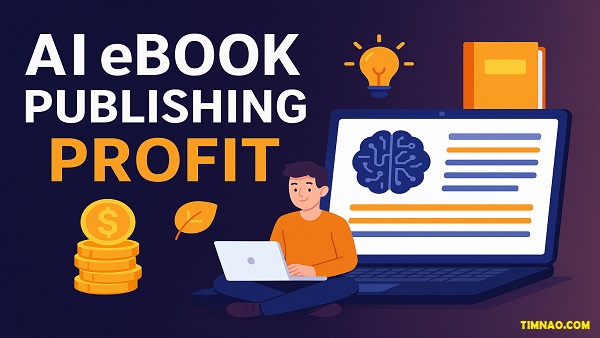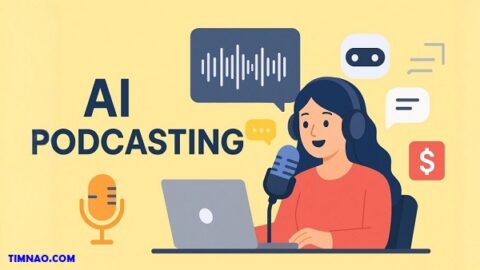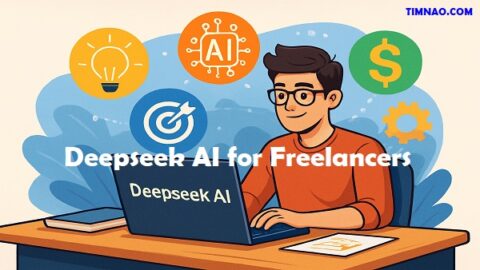🚀 Master AI Publishing to Build a Profitable eBook Empire (Even as a Total Beginner!)
AI ebook publishing is revolutionizing the way first-time authors, entrepreneurs, and content creators share knowledge and generate income online. In 2025, you no longer need to be a tech expert, professional writer, or marketing guru to publish a high-quality eBook that sells. With the help of AI, even complete beginners can now go from blank page to global bestseller—faster, smarter, and with minimal cost.
Whether your goal is to build passive income, grow your personal brand, or launch a digital product empire, this guide will walk you through every step of the process—from finding a profitable idea to formatting, publishing, and promoting like a pro. You’ll discover how to use powerful AI tools to save time, improve content quality, and maximize your profits, even if you’ve never written a book before.
Let’s unlock the full potential of AI and turn your ideas into a real, revenue-generating digital asset.
👇 Dive into the step-by-step roadmap below:
📚 Table of Contents
- 🌟 Why AI eBook Publishing is Booming in 2025
- 🔍 Find a Profitable Niche with AI Tools
- ✍️ Generate Winning eBook Ideas Using AI
- 🧠 Write Smarter, Not Harder: AI-Assisted Content Creation
- ✨ Edit and Format Like a Pro with AI
- 🎨 Create Stunning Covers with AI Visual Tools
- 💸 Smart Pricing Strategies for Maximum Profits
- 🌍 Distribute Your eBook Like a Pro
- 📈 Market Your eBook Using AI-Powered Promotion
- 📊 Track Performance and Scale for Growth
- ❓ FAQs: Common Questions from First-Time AI Authors
🌟 Why AI eBook Publishing is Booming in 2025
In 2025, AI eBook publishing has gone from trend to transformative force. It’s empowering everyday creators—bloggers, solopreneurs, digital marketers, educators, and side hustlers—to build profitable online book businesses without relying on traditional publishers or expensive ghostwriters.
Why now? Because we’re living through a revolution in how content is created, packaged, and sold. AI tools like ChatGPT, Claude, Grammarly, and Midjourney are democratizing publishing, giving solo creators the same creative firepower that publishing houses once monopolized.
🔥 What’s Fueling the AI Publishing Boom?
- Faster Time to Market: AI reduces content creation and editing cycles from months to days. What used to take 6 months can now be done in 2 weeks—with better results.
- Drastically Lower Costs: You no longer need to hire editors, designers, or marketers. AI tools can now do all of that—often better and faster—for a fraction of the cost.
- Content Demand Is Exploding: The rise of self-paced learning, remote work, and niche online communities has created an insatiable demand for digital information products, especially well-targeted eBooks.
- Global Reach with Zero Inventory: Thanks to platforms like Amazon KDP, Gumroad, and Draft2Digital, you can sell eBooks worldwide without shipping or storage.
- AI Personalization: AI-driven recommendations, dynamic pricing, and reader behavior insights help tailor each book’s presentation for maximum impact and conversion.
Even Forbes and Fast Company are now profiling solo entrepreneurs turning AI-assisted eBooks into 5- and 6-figure revenue streams. The industry is shifting, and smart creators are seizing the moment.
💡 Big takeaway: You no longer need to be a bestselling author to build a profitable publishing business. You just need a good idea, smart tools, and a data-driven strategy.
🔍 Find a Profitable Niche with AI Tools
Before you write a single word, you need to choose the right niche—one where reader demand meets your interests and expertise. This is the foundation of profitable publishing, and AI gives you a massive advantage here.
Gone are the days of gut-feeling decisions. AI can analyze market trends, search queries, and audience gaps in seconds, helping you make data-backed decisions that minimize risk and maximize opportunity.
🛠️ AI Tools That Help You Nail Your Niche
Here’s how to use modern tools to find lucrative, low-competition niches:
✅ Step 1: Discover Trends Before They Go Mainstream
- Use Google Trends or Exploding Topics to see what topics are growing fast in popularity.
- Ask ChatGPT:
“What eBook topics are trending on Amazon Kindle in the health & wellness niche for women over 40?”
✅ Step 2: Analyze Amazon Data
- Search top Kindle categories and filter by Bestsellers.
- Use Helium 10 or Publisher Rocket to check search volume, keyword competitiveness, and estimated earnings for book titles.
- Look for sub-niches that are underserved. Example: instead of “Productivity,” go for “Time Management for Remote Moms.”
✅ Step 3: Match Passion with Profit
While data matters, your enthusiasm is essential. AI can help you analyze your own content history (blogs, videos, social media) to find recurring themes in your work.
Try this ChatGPT prompt:
“Analyze the last 10 topics I wrote about. Which ones have the highest potential for niche ebook success?”
✅ Step 4: Identify Reader Pain Points
Use AI to conduct sentiment analysis on:
- Amazon reviews
- Reddit discussions
- Quora questions
- TikTok comment threads
Ask: What are readers frustrated with? What’s missing from existing books?
AI can quickly synthesize this data and give you laser-targeted gaps to fill.
📈 Example Niches (Hot in 2025)
| Niche | Why It’s Profitable |
|---|---|
| AI for Freelancers | Surging due to gig economy + automation needs |
| Digital Wellness for Gen Z | Post-screen-time burnout solutions are trending |
| AI Relationship Journaling | Blends mental health + personalized AI writing tools |
| Financial Literacy for Teens | Major demand from educators and parents |
🧠 AI + Market Research = Unfair Advantage
With AI tools at your side, you can:
- Predict trends instead of chasing them
- Spot micro-niches your competitors miss
- Test ideas with data, not guesswork
- Optimize for real search behavior
🧭 Pro Tip: Create a short poll or quiz with AI tools and distribute it to niche Facebook groups or email lists. Use the results to validate niche interest before writing.
✍️ Generate Winning eBook Ideas Using AI
So, you’ve chosen your niche—great. But how do you come up with an eBook idea that stands out, sells well, and delivers real value?
That’s where AI idea generation becomes your secret weapon.
In 2025, the best eBook creators don’t just write—they strategize using data. AI can help you uncover what readers are truly craving—topics with high interest, low saturation, and clear emotional demand.
🔍 Use AI to Uncover eBook Topics with Precision
Start with the question:
“What problems are readers in my niche trying to solve right now?”
AI tools can crawl online conversations, search queries, book reviews, and news cycles to generate laser-focused, high-potential book angles.
💡 How to Prompt ChatGPT or Claude:
“Based on Kindle trends, YouTube comments, and Reddit threads, give me 10 fresh eBook title ideas in the ‘budget travel for digital nomads’ niche.”
Or get more specific:
“What unique ebook angles are missing from the top 20 Amazon Kindle books in the parenting-for-teenagers category?”
📊 Combine AI + Trend Platforms:
- Exploding Topics: Discover fast-rising search trends before they go mainstream.
- AnswerThePublic: Pulls actual search questions for long-tail content.
- Google’s “People Also Ask”: Helps AI shape your outline around real search behaviors.
- Subreddit + Review Analysis with AI: Ask ChatGPT to summarize insights from r/selfimprovement, r/ebooks, or Goodreads reviews in your niche.
📘 Idea Categories That Convert (2025-Ready)
| Type | Example |
|---|---|
| “Quick Win” Guides | “30-Minute Productivity Systems for New Remote Workers” |
| Micro-Niche How-Tos | “Meal Prepping for Women With PCOS” |
| AI Companion Books | “Mastering Canva AI for Freelance Designers” |
| Personal Development with a Twist | “Self-Help for Gamers: Unlocking Real-Life Achievements” |
| Interactive eBooks | “Journaling with ChatGPT: A 21-Day Mindset Challenge” |
✨ Hot tip: Use AI to combine two unrelated trending topics into something unique (e.g., “AI Tools for Co-Parenting After Divorce”).
🧠 Idea Validation = Less Risk, More Profit
Before writing, test your idea. Let AI help you validate it:
- Ask ChatGPT to simulate a focus group’s reaction
- Run polls using AI-generated questions on Reddit, LinkedIn, or Instagram
- Use PickFu to A/B test titles or cover ideas
📈 If nobody’s searching for it—or the competition is extreme—pivot your angle before investing time.
🧠 Write Smarter, Not Harder: AI-Assisted Content Creation
Once your idea is locked, it’s time to bring your eBook to life—fast, professionally, and without burnout.
In the AI-powered creator economy, writing an eBook no longer means staring at a blank screen. Smart creators use AI to draft, polish, and perfect their work—while still preserving their unique voice.
✍️ Step-by-Step AI Writing Workflow
✅ Step 1: Outline Like a Pro
Use AI to structure your eBook before writing.
Prompt:
“Create a detailed chapter-by-chapter outline for an eBook titled ‘Digital Minimalism for Creators: How to Build Online Without Burnout’.”
AI will map out:
- Chapters & subheadings
- Key takeaways
- Suggested word count
🎯 Pro tip: Ask for multiple outline styles (tutorial, storytelling, problem-solution) and choose the one that best fits your goals.
✅ Step 2: Draft Collaboratively
Don’t rely on AI to write your entire book. Use it to co-draft, then inject your voice, expertise, and experiences.
Prompts to accelerate your writing:
- “Write a 500-word draft of Chapter 3 using a friendly, conversational tone.”
- “Expand this bullet point into a paragraph with a practical example.”
- “Suggest a metaphor to explain ‘decision fatigue’ in a fun way.”
🧠 Use tools like:
- Notion AI or Ghostwriter by Reedsy for in-app drafting
- Jasper AI for long-form generation
- ChatGPT Custom GPTs for outlining and restructuring
✅ Step 3: Enhance, Don’t Replace
AI is brilliant for:
- Rewriting passive sentences
- Creating summaries for each chapter
- Suggesting stronger intros and conclusions
- Keeping tone consistent across chapters
Ask:
“How can I make this introduction more engaging for beginner readers?”
💬 Voice + Authenticity Still Matter
AI can write, but only you can connect. Add:
- Personal stories
- Case studies
- Original insights
- Humor or quirks that make it you
🤖 Let AI handle the structure and clarity, but let your human side bring the soul.
📘 Real Example: AI + Human = Bestseller
In early 2025, author Jessica Rae released “Confidence for Shy Creators”, written using ChatGPT + her coaching insights. Her process:
- AI helped generate an outline and draft raw content.
- She added real stories from her client work.
- Grammarly AI refined the tone.
- Jasper created social promo snippets.
🚀 The result? #1 in three categories on Amazon within 2 weeks—with zero ad spend.
📢 Why This Matters for Beginners
You don’t need to be an expert writer to create a high-quality, market-ready eBook in 2025.
You just need:
- A validated idea
- A clear outline
- AI to handle structure, repetition, flow
- Your authentic voice to tie it all together
The rest? Technology’s got your back.
✨ Edit and Format Like a Pro with AI
You’ve drafted your eBook—now it’s time to polish it. Great editing and formatting are what separate amateur work from bestselling books. But here’s the truth: doing it manually is slow, tedious, and error-prone.
Thankfully, AI editing and formatting tools in 2025 make it fast, affordable, and professional—even for first-time authors.
✂️ AI-Powered Editing: Fix More Than Just Grammar
Forget basic spellcheckers. Today’s AI editing tools offer:
- Real-time feedback on tone, clarity, and sentence flow
- Suggestions based on genre (e.g., persuasive, academic, storytelling)
- Emotional tone analysis to match your intended impact
🧠 Best Tools for AI Editing:
- Grammarly Premium: Now includes AI rewriter, tone improvement, and even goal setting based on intent.
- ProWritingAid: Excellent for long-form eBooks; analyzes pacing, overused words, and readability.
- Hemingway Editor: Simplifies sentence structure and improves clarity.
- ChatGPT: Ask it to:
“Revise this paragraph to sound more persuasive and beginner-friendly.”
“Check this chapter for passive voice and repetition.”
📐 Formatting: The Invisible Hero of Reader Experience
Clean formatting isn’t just about aesthetics—it’s about reader retention. Blocky paragraphs, inconsistent fonts, or sloppy spacing will tank your credibility fast.
🧰 AI Formatting Tools That Save You Hours:
- Atticus: Full-service eBook formatting + export for Kindle, EPUB, print. Great for beginners.
- Reedsy Book Editor: Drag-and-drop formatting + automatic table of contents and chapter styling.
- Vellum (Mac only): Used by pros to create beautiful, print-ready books in minutes.
Ask ChatGPT:
“Format this list into a clean bulleted section for an eBook targeting Gen Z readers.”
“Turn this block of text into a boxed tip or quote format.”
💡 Formatting Best Practices (AI-Enhanced)
✅ Use clear H1, H2, and H3 structure
✅ Include consistent spacing and alignment
✅ Add styled quote boxes or quick tips for visual breaks
✅ Use chunking: 3–5 sentence paragraphs max
✅ Insert clickable Table of Contents (AI tools can generate this!)
🧠 Pro Tip: Ask AI to “simulate” how your eBook looks on Kindle, mobile, and tablet—and adjust formatting for different screens accordingly.
🔁 Combine AI + Human Oversight for Best Results
Let AI handle:
- Typos, grammar, sentence flow
- Headings, indentation, alignment
- Smart spacing and font consistency
Then YOU review for:
- Message accuracy
- Voice and brand tone
- Transitions and emotional resonance
🚀 The result? A clean, professional-grade eBook ready to convert readers into raving fans.
🎨 Create Stunning Covers with AI Visual Tools
Your cover is your eBook’s first impression—and in 2025, readers really do judge books by it. With thousands of titles competing on platforms like Amazon or Apple Books, your cover must instantly grab attention and communicate the value inside.
But here’s the good news: You don’t need to hire a $500 designer.
AI-powered design tools now let anyone create jaw-dropping covers—even with zero design background.
🧠 Why AI-Driven Cover Design Works Better
AI doesn’t just generate graphics—it analyzes:
- What’s trending in your niche
- Color psychology that influences click-through rates
- Font choices proven to increase buyer trust
- Visual competitors so you can stand out (not blend in)
Example: If mystery thrillers in 2025 are trending with neon green titles and gritty backgrounds, AI tools will suggest a design to match—or smartly diverge.
🎨 Top AI Cover Design Tools in 2025
🔧 Canva Pro with Magic Studio
- Pre-built eBook templates
- AI-powered layout suggestions
- Drag-and-drop interface
- Resize instantly for Amazon, Instagram, Pinterest, etc.
🎨 MidJourney or Leonardo AI
- Generate ultra-realistic or fantasy-style art based on prompts
- Perfect for sci-fi, self-help, fantasy, memoirs
Example Prompt for MidJourney:
“Design a minimalist eBook cover with soft lavender background, a confident female figure, and the title ‘Anxious But Ambitious’ in serif typography.”
📚 BookBrush
- Create 3D mockups for marketing
- Add overlays like “#1 New Release” or “Free on Kindle Unlimited”
- Design back and spine for print
📌 Cover Design Tips (Backed by AI)
| Element | Tip |
|---|---|
| 📘 Title | Keep it bold, readable at thumbnail size |
| 🎨 Color | Use emotion-driven palettes (e.g., blue = trust, red = urgency) |
| 🖋 Font | Stick to 1–2 fonts max; use contrast |
| 👁 Imagery | Use genre-aligned visuals that spark curiosity |
🤖 Ask ChatGPT:
“Give me 5 examples of cover copy that increases conversions for a productivity book aimed at Gen Z freelancers.”
🔁 Test & Improve with AI
Run A/B tests using:
- PickFu (real-time feedback from target readers)
- Social polls or AI-analyzed Reddit threads
- Prompt ChatGPT to:
“Simulate which of these two covers would get more clicks from a 30-year-old remote worker.”
💡 Brand Consistency = Long-Term Recognition
If you plan to write a series, use AI to:
- Suggest color palettes and layouts that evolve across books
- Maintain visual branding across your author platform, website, and social media
📚 Example: Your eBook “Side Hustles with AI” might be followed by “Freelancing with AI” and “Scaling with AI”—each with a consistent font, icon style, and brand color.
💸 Smart Pricing Strategies for Maximum Profits
You’ve created your eBook. Now comes one of the most misunderstood steps: pricing.
In 2025, smart pricing isn’t about guessing—it’s about strategy. The goal is to maximize perceived value while staying competitive, and AI tools can now help you analyze, test, and optimize your prices for more downloads and higher royalties.
📊 Understand How eBook Pricing Works
If you’re publishing on Amazon KDP, here’s a quick royalty breakdown:
- $0.99–$2.98: 35% royalty
- $2.99–$9.99: 70% royalty (best for most creators)
- $10+: Drops back to 35%
💡 That’s why many indie authors aim for the sweet spot between $2.99–$6.99—a balance between affordability and profit.
But that’s just the beginning. Let’s level up.
🧠 Use AI to Optimize Pricing
AI tools can now analyze competitor pricing, keyword traffic, and buyer intent. You can ask ChatGPT or Claude:
“Analyze top 10 Amazon Kindle books in the productivity niche. Suggest an optimal price for a 15,000-word eBook targeting millennial freelancers.”
AI will review:
- Current pricing trends
- Buyer psychology
- Seasonality (e.g., Q4 buyers tend to spend more)
🧪 Run Smart A/B Price Tests
Platforms like KDP Rocket (Publisher Rocket) or BookBeam let you test multiple prices and track performance in real time.
Or, ask AI to simulate this:
“What might happen to conversions if I price my eBook at $4.99 vs $2.99 for Gen Z readers looking for freelance income?”
Combine this with real-time feedback on:
- CTR (click-through rate)
- Sample download rate
- Full purchase conversion
💡 Pricing Strategies That Work in 2025
| Strategy | How It Works |
|---|---|
| Tiered Pricing | Offer eBook alone at $4.99 and a bundle with bonus templates at $9.99 |
| Early Bird Discount | Launch at $0.99 to spike visibility, then raise after 7–10 days |
| Psychological Pricing | Use $3.97 or $6.49 instead of round numbers |
| Premium Positioning | Charge $12.99+ if you’re including proprietary systems or visuals (e.g., workbook, framework) |
🎯 Pro Tip: Use urgency and scarcity in AI-generated sales copy to justify higher pricing.
🤖 AI Can Predict Reader Perceived Value
Feed your eBook title, description, and bonus materials into ChatGPT and ask:
“Does this package justify a $7.99 price point for readers in the digital marketing space?”
The AI will analyze tone, benefit structure, and comparison value.
Remember: people don’t pay for word count—they pay for transformation.
🌍 Distribute Your eBook Like a Pro
Publishing is no longer limited to Amazon. In 2025, wide distribution = wider income. With AI tools simplifying the process, there’s no reason not to put your book everywhere readers are looking.
Let’s break down the smartest, most beginner-friendly options—and how AI helps you do it all faster.
📦 Option 1: Amazon KDP (Your Must-Have Platform)
Still the #1 eBook marketplace.
It offers:
- Massive built-in audience
- 70% royalty on $2.99–$9.99
- Kindle Unlimited visibility (via KDP Select)
- Easy print-on-demand (Paperback + Hardcover via Kindle Print)
✅ AI-Powered Optimization Tips:
- Use ChatGPT to write a keyword-rich description:
“Rewrite this description for SEO using keywords related to ‘AI productivity hacks for solopreneurs’.”
- Let AI help choose 7 backend keywords that match reader intent and current trends.
🛑 Note: Enrolling in KDP Select means exclusivity—you can’t sell your eBook elsewhere digitally during that 90-day term.
🌐 Option 2: Go “Wide” with Draft2Digital
Want to distribute beyond Amazon? Use Draft2Digital. It pushes your book to:
- Apple Books
- Kobo
- Barnes & Noble
- OverDrive (library distribution)
- Tolino and more
🎯 Pro Tip: Use AI to adjust your formatting for each platform’s best practices.
Ask:
“Format this eBook with chapter titles styled for Apple Books and Kobo.”
🛒 Option 3: Sell Direct with Gumroad or Payhip
If you want:
- Higher profit margins
- Instant payouts
- Full control of pricing, branding, and customer data…
Then direct-to-reader sales through platforms like Gumroad or Payhip are perfect.
AI makes this easier by:
- Generating product page copy
- Writing FAQs and refund policy pages
- Suggesting upsells (e.g., audiobook version, coaching session)
🧠 AI-Powered Distribution Checklists
Use AI to create dynamic checklists tailored to your genre and goals.
Example prompt:
“Create a launch distribution checklist for a self-help eBook aimed at 30–50 year-old moms in the U.S.”
Your checklist might include:
- KDP upload
- Gumroad integration
- BookFunnel link setup
- Facebook Ads pixel installed
- AI-optimized metadata added
📢 Don’t Forget to Localize!
With tools like Deepl + GPT translation, you can now distribute your book in:
- Spanish
- German
- Portuguese
- Japanese
…without paying a translator thousands.
Prompt ChatGPT:
“Translate this chapter into neutral Spanish for Latin American readers, keeping a friendly and casual tone.”
📈 Market Your eBook Using AI-Powered Promotion
Writing your eBook is just half the journey—getting people to discover and buy it is where the real challenge (and reward) lies.
In 2025, smart eBook marketing isn’t about guesswork—it’s about automation, personalization, and scale. AI allows even solo authors to launch like pros with automated content, optimized ads, and hyper-targeted campaigns.
🧠 Build a High-Converting Marketing Funnel with AI
Here’s how AI helps you plan and execute a launch funnel from scratch:
- Awareness
- Use ChatGPT or Jasper AI to create short-form content (tweets, Instagram captions, LinkedIn posts) that tease your book’s core promise.
- Tools like Ocoya or Buffer AI can auto-schedule and personalize posts for every platform.
- Engagement
- Create a freebie or “lead magnet” using AI (e.g., the first chapter, a bonus checklist).
- AI can also help generate landing page copy using platforms like Copy.ai or Writesonic.
- Conversion
- Use AI to write Amazon description bullets in AIDA or PAS format.
- Let Jasper or ChatGPT simulate an Amazon review to help test your sales copy structure.
💬 Example prompt:
“Write 3 persuasive hooks for a book about time management for ADHD entrepreneurs, with curiosity-driven tone.”
🔄 Retarget Like a Pro
With tools like ManyChat + ChatGPT, you can build:
- Messenger bots that re-engage readers
- Custom autoresponders that follow up with visitors who didn’t buy
- Quiz funnels that guide users to the right product
🧠 AI can analyze click behavior and rewrite your emails or ads for better engagement.
🎯 Smart Ads, Smarter AI Copy
AI tools like AdCreative.ai or Pencil now generate full ad campaigns:
- Text headlines
- Image variations
- Predictive performance scores
Pair that with Facebook Ad Manager + ChatGPT to define your audience:
“Build a cold audience targeting Gen Z freelancers in urban U.S. cities interested in side hustles and digital nomadism.”
📣 Use AI to Maximize Launch Buzz
- Generate countdown scripts, email subject lines, and product update blurbs
- Animate teaser videos or quote cards in Canva Magic Studio or Lumen5
- Schedule a 14-day pre-launch and 7-day post-launch sequence—with subject lines and body text AI-written, sentiment-optimized, and conversion-tested
🤖 Let AI handle the busywork so you can focus on reader connection.
📊 Track Performance and Scale for Growth
What gets measured, gets improved—and in eBook publishing, tracking performance is the key to long-term success.
With AI, you can now go far beyond vanity metrics like “likes” or “downloads.” You can measure reader behavior, sales conversion paths, keyword performance, and more.
🛠️ AI Tools for Analytics & Growth
📈 1. Amazon KDP Reports
- View page reads, units sold, royalties, and territory distribution
- Export your data and ask ChatGPT:
“Analyze this report and identify my top 3 sales days and which keywords performed best.”
📊 2. BookBeam, K-lytics, or Publisher Rocket
- Track competitor performance
- See what keywords and categories are gaining steam
- AI will suggest which to enter next
💻 3. Google Analytics + ChatGPT
- Track traffic to your Gumroad landing pages
- Ask:
“Which traffic source is driving the most conversions, and what is the bounce rate on mobile?”
🔁 Scale Up: Your eBook Is Just the Beginning
✅ Package your book into a course
✅ Launch an email challenge using chapters
✅ Bundle with your next eBook or digital product
✅ Create a print-on-demand workbook or journal using AI-formatted prompts
🎯 Ask AI:
“What additional product or content funnel can I build using my book ‘AI for Side Hustlers’ as the core offer?”
🧠 Use your eBook as a flywheel to grow a brand, newsletter, YouTube channel, or entire creator business.
❓ FAQs: Common Questions from First-Time AI Authors
❓Can I really write a quality book with AI if I’m not a writer?
Absolutely. AI gives you structure, inspiration, and clarity—but your voice still matters. Many beginners use AI to overcome writer’s block, speed up first drafts, or improve clarity without losing authenticity.
❓Will using AI get me banned on Amazon KDP?
No, as of 2025, Amazon KDP allows AI-assisted books as long as they are original, high-quality, and follow content policies. However, fully AI-generated spam or plagiarism can get flagged. Use AI responsibly—always add your unique input.
❓How long does it take to publish an AI-assisted eBook?
Typically 7–21 days from idea to published, depending on book length, formatting needs, and your time commitment. AI can cut production time by 60–80%.
❓What are the startup costs?
AI eBook publishing can be started for under $100, especially if using free or freemium tools like:
- ChatGPT Free or Claude AI
- Canva Free
- Reedsy Book Editor
- Gumroad (0 upfront cost, small fee per sale)
Optional premium tools can increase speed and results but are not essential.
❓How do I protect my AI-generated content?
Register your eBook with the U.S. Copyright Office (AI-assisted works are currently eligible if there’s substantial human contribution). You can also add a creative commons license, and track plagiarism using tools like Originality.ai.
❓Do I need a website to sell my book?
No, but it helps. Many authors start with just Amazon KDP or Gumroad. Later, you can use AI to help build a landing page on Carrd, Systeme.io, or WordPress.
🔚 Final Thoughts: Use AI to Publish, Profit & Empower
AI is not replacing authors—it’s empowering them. It’s helping beginners publish faster, reach more people, and build meaningful income around their knowledge.
In 2025, writing and selling a high-quality eBook isn’t a dream—it’s a process. And with AI, that process is simpler, smarter, and more profitable than ever.
Now it’s your turn.
✅ Choose your niche
✅ Use AI to build your idea
✅ Publish your book
✅ Promote like a pro
✅ Scale into a brand
✨ The tools are here. The readers are ready. Let’s build your eBook empire.
Reference video:









